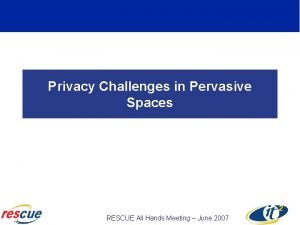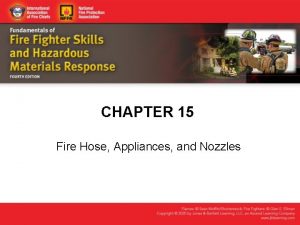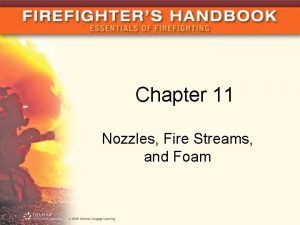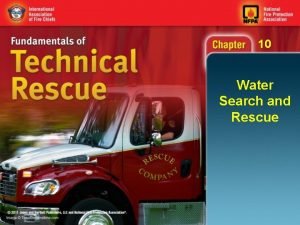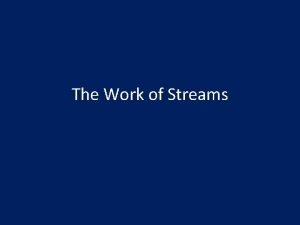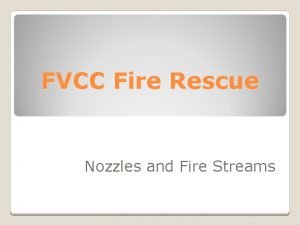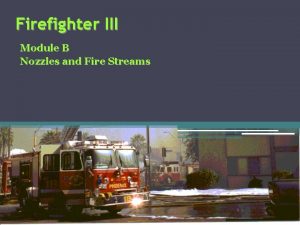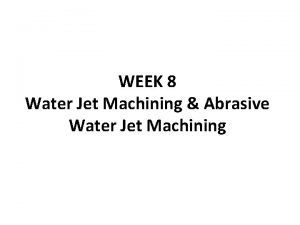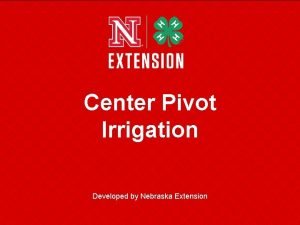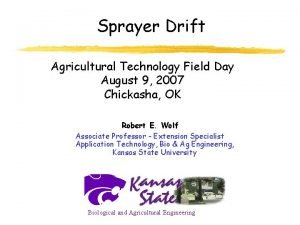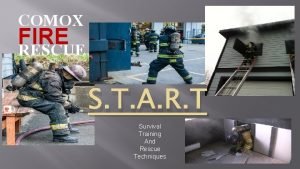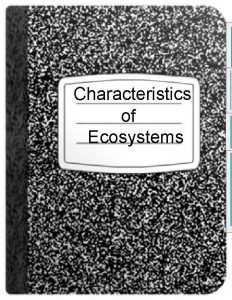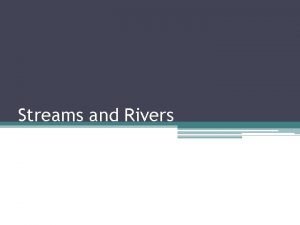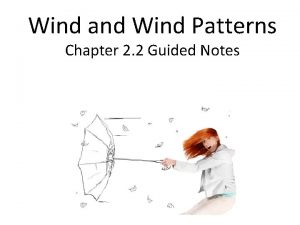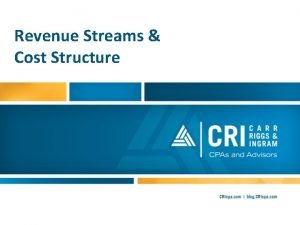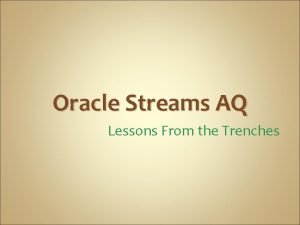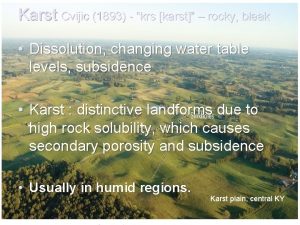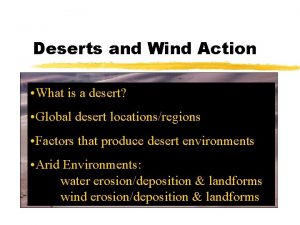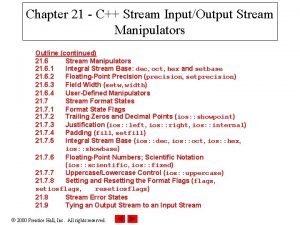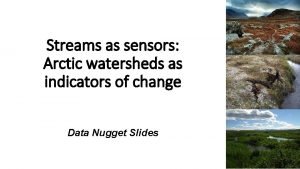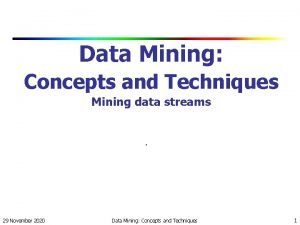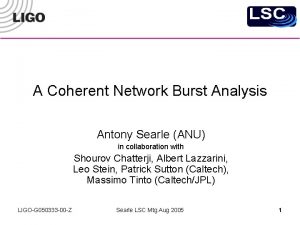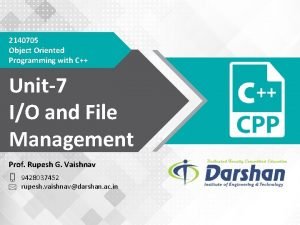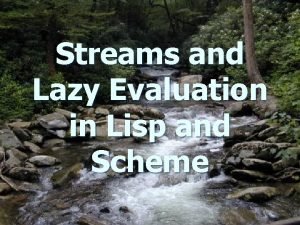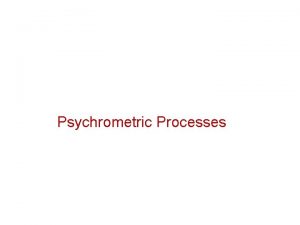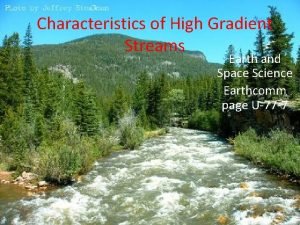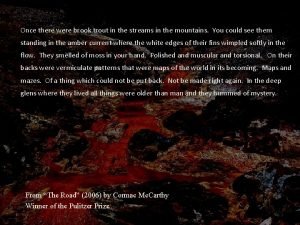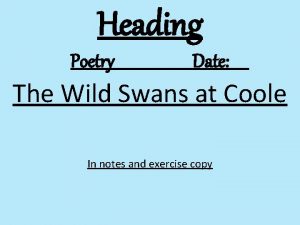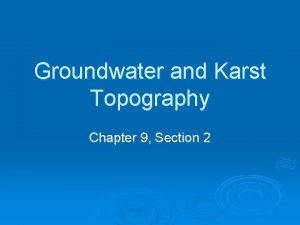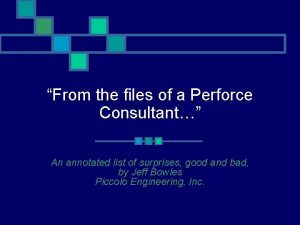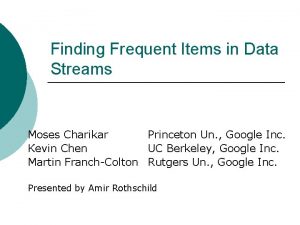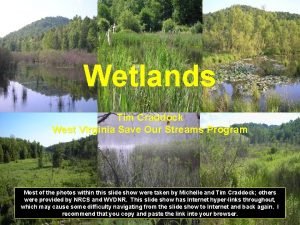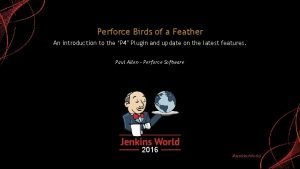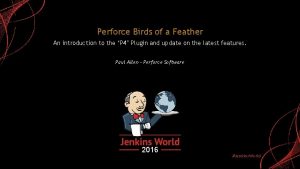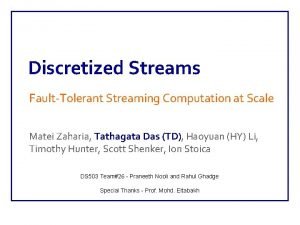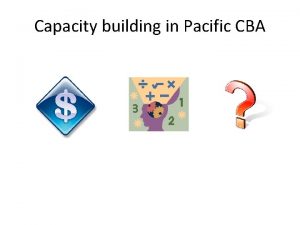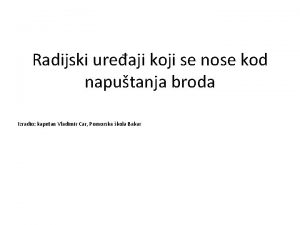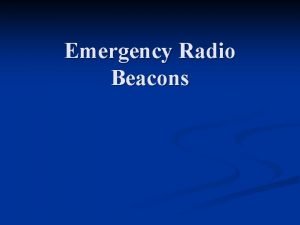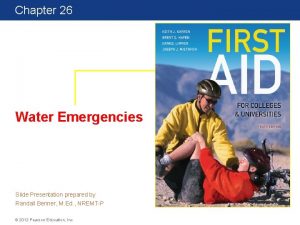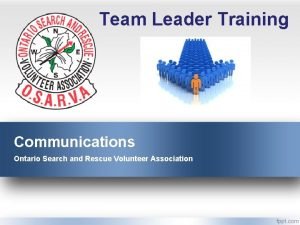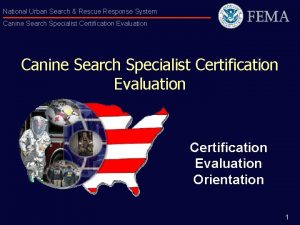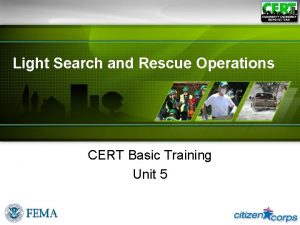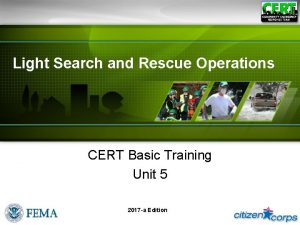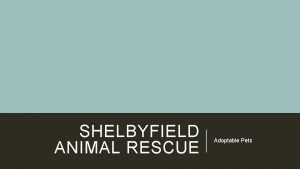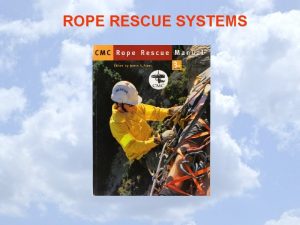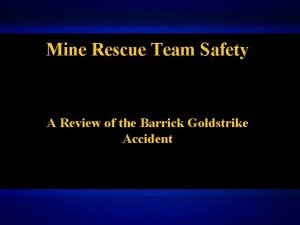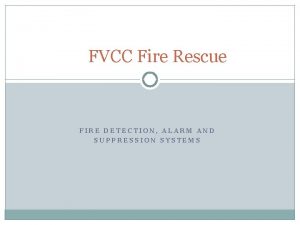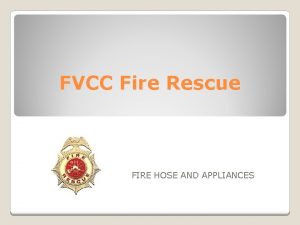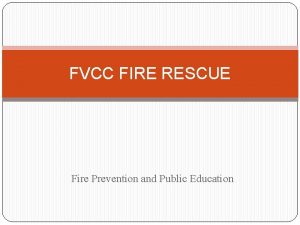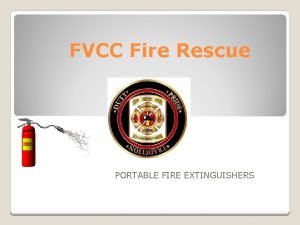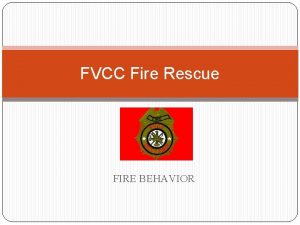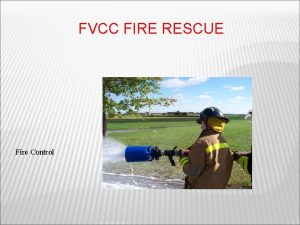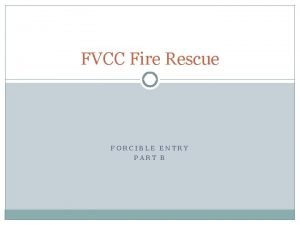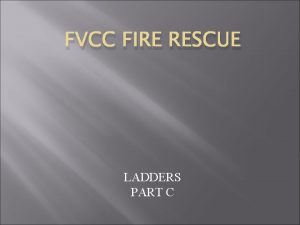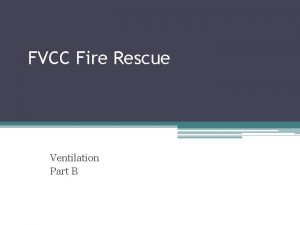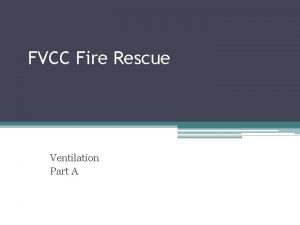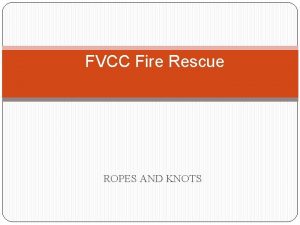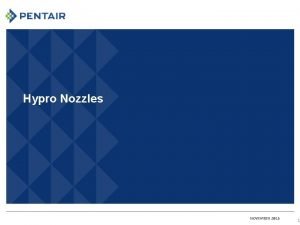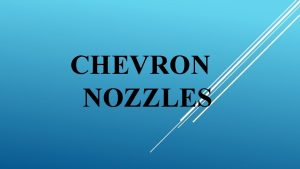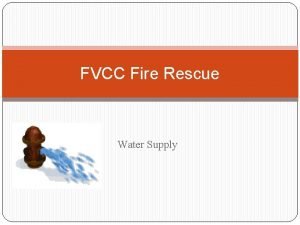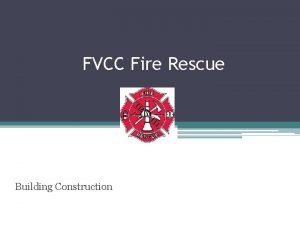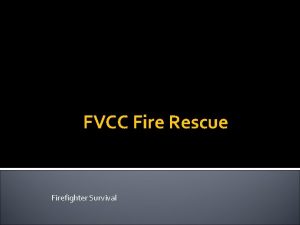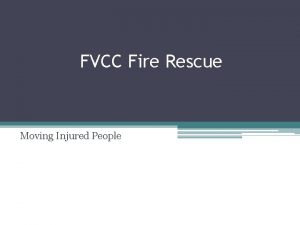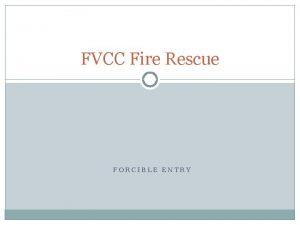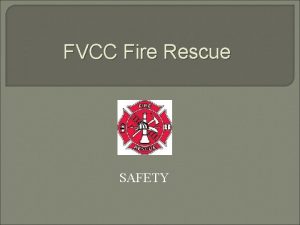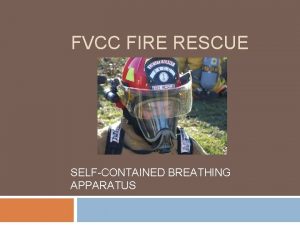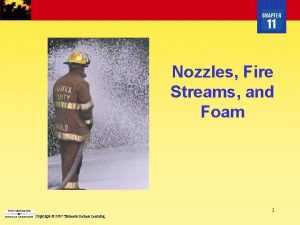FVCC Fire Rescue Nozzles and Fire Streams Part






































































- Slides: 70

FVCC Fire Rescue Nozzles and Fire Streams Part B

�Solid stream handline nozzles ◦ Attach proper size tip to shutoff ◦ Slowly open bail to bleed off air ◦ Slowly open and close the nozzle using the bail OPERATION OF FIRE STREAM NOZZLES

�Solid stream master stream nozzles ◦ Position device for use ◦ Check for proper tip size for volume to be delivered ◦ Make sure device is secured using supplied attachment device ◦ Have appliance charged ◦ Elevate and/or rotate nozzle slowly for maximum reach and penetration OPERATION OF FIRE STREAM NOZZLES


�Fog stream handline nozzle ◦ Check to make sure nozzle is set to desired pattern and gallonage (if adjustable) ◦ Slowly open bail to bleed off air ◦ Slowly open the nozzle using the bail ◦ Adjust fog pattern as desired ◦ Slowly close the nozzle using the bail OPERATION OF FIRE STREAM NOZZLES


�Fog master stream nozzles ◦ Position device for use ◦ Check for desired pattern and gallonage (if adjustable) ◦ Make sure device is secured using supplied attachment device ◦ Have appliance charged ◦ Elevate an/or rotate nozzle slowly for maximum reach and penetration ◦ Adjust fog pattern as desired OPERATION OF FIRE STREAM NOZZLES


�Broken stream ◦ Water curtain nozzles �Position device for use �Secure in place �Have appliance charged �Adjust so that it is spraying on exposure to be protected ◦ Cellar or distributor nozzle �Position nozzle for use �Have device charged �Check for proper placement and reach �Secure or support in place so nozzle rotation does not displace it OPERATION OF FIRE STREAM NOZZLES

◦ Piercing nozzle �Position nozzle for penetration �Drive nozzle into position with a striking tool �Open nozzle slowly OPERATION OF FIRE STREAM NOZZLES

BROKEN STREAM (SPECIAL PURPOSE) NOZZLES Broken/Penetrating Nozzle Distributor Chimney Nozzle Distributor (Cellar) Nozzle VS 13 -16

VS 13 -17 USING A DISTRIBUTOR NOZZLE Effective Ineffective

VS 13 -18 USING A CHIMNEY NOZZLE A booster hose and nozzle are dropped down the entire length of the chimney and then pulled back out. Mist from the nozzle turns to steam and chokes the fire.

USING A PIERCING NOZZLE Using a sledgehammer to Drive the Point of the Piercing Nozzle Through the Obstruction VS 13 -19

�Definition ◦ The force of nature that makes the nozzle move in the opposite direction of the water flow. The nozzle operator must counteract the thrust exerted by the nozzle to maintain control. NOZZLE PRESSURE EFFECTS

�Solid stream ◦ Flow rate is dependant on the velocity of the stream and ◦ ◦ ◦ ◦ size of discharge opening Increase of size of discharge orifice or velocity will increase flow Nozzle tip size should not be more than one-half the diameter of the hose The greater the discharge pressure, the greater the reach Maximum horizontal reach is attained at an angle of 32 degrees Vertical reach into structures is best at a 70 -75 degree angle Greatest vertical reach is a 90 degree angle Wind will affect stream shape and reach NOZZLE PRESSURE EFFECTS

�Fog stream ◦ Flow rate is dependent on type of nozzle (constant, adjustable gallonage, automatic) pressure and stream pattern) ◦ The wider the fog pattern, the shorter the reach ◦ Once maximum reach has been attained, increases in nozzle pressure have little effect on reach and limited increase in volume ◦ Low nozzle pressure reduces velocity, reach and volume NOZZLE PRESSURE EFFECTS

◦ Factors affecting reach: �Gravity �Water velocity �Pattern of nozzle �Friction of water against air �Wind NOZZLE PRESSURE EFFECTS


�Nozzle reaction: Newton’s Third Law: For every action, there is an equal and opposite reaction �The greater the nozzle discharge pressure, the greater the nozzle reaction NOZZLE REACTION

�Definition: Sudden stopping of water flow resulting in surge of energy in opposite direction �Effects: Broken pipes, hoses, pumps and hydrants �Prevention: Open and close valves slowly �Cause: Rapid/sudden closing of nozzles or valves WATER HAMMER

�Fire “darkens” down �Thermal layer is maintained �Visibility is not decreased PROPER APPLICATION OF FIRE STREAM

�Watch for over-pressurization �Operate handlines with minimum of two firefighters �Remain aware of fire conditions �Follow personal safety procedures HANDLING OF FIRE HOSE

�Methods of preventing damage ◦ Open nozzles and other appliances slowly ◦ Close nozzles and other appliances slowly ◦ Avoid dropping nozzles and appliances ◦ In cold weather, leave nozzles cracked open to prevent freezing PREVENTING DAMAGE

�Types fuel) of ground cover fires (classified by ◦ Ground fuels (duff): small twigs, leaves and needles ◦ Surface fuels: living surface vegetation including grass, brush and other low vegetation. ◦ Aerial fuels: Suspended and upright fuels physically separated from the ground fuels to the extent that air can circulate freely around the fuels causing them to burn more readily. GROUND COVER FIRES

�Perimeter control ◦ Control line may be established �Burning edge of the fire �Next to the edge of the fire �At a considerable distance from the fire ◦ Attack methods �Direct action is taken directly against the flames �Indirect used at varying distances from the fire EXTINGUISHING GROUND COVER FIRES

◦ Ten Standing Orders �Fight fire aggressively but provide for safety first �Initiate all action based on current and expected fire behavior �Recognize current weather conditions and obtain forecasts �Ensure instructions are given and understood �Obtain current information of fire status EXTINGUISHING GROUND COVER FIRES

�Remain in communication with crew members, your supervisor and adjoining forces �Determine safety zones and escape routes �Establish lookouts in potentially hazardous situations �Retain control at all times �Stay alert, keep calm, think clearly, act decisively EXTINGUISHING GROUND COVER FIRES

VS 13– 1 HOW FOAM WORKS Separates Cools Suppresses

TS 13– 1 WAYS FOAM EXTINGUISHES �Separation �Cooling of fuel and heat source the fuel and surrounding surfaces �Suppression of flammable vapors

TS 13– 2 HYDROCARBON FUELS � Petroleum based � Float on water � Examples ◦ Crude oil ◦ Fuel oil ◦ Gasoline ◦ Benzene ◦ Naphtha ◦ Jet fuel ◦ Kerosene

TS 13– 3 POLAR SOLVENT FUELS �Flammable liquids �Mix with water �Examples ◦ Alcohols ◦ Esters ◦ Acids ◦ Acetone ◦ Lacquer thinner ◦ Ketones

TS 13– 4 SPECIALIZED FOAM FIRES �Acid spills �Pesticide fires �Confined- or enclosed-space fires �Deep-seated �Unignited Class A fires hazardous materials spills

VS 13– 2 FOAM TETRAHEDRON Co Foa nc m en tra t e l ica an ch ion Me gitat A Air Water Air Me c Ag han ita ica tio l n C am rate o F nt ce n o Water

TS 13– 6 ELEMENTS OF FIRE FIGHTING FOAM �Foam concentrate �Water �Air �Mechanical agitation

TS 13– 7 FOAM GENERATION METHOD �Water is mixed with foam concentrate to form a foam solution. �The foam solution passes through the hoseline to a foam maker. �The foam maker aerates the foam solution to form finished foam.

VS 13– 3 COMPONENTS OF FOAM PRODUCTION Finished Foam Proportioner Water Foam Solution Foam Concentrate

TS 13– 8 COMPONENTS OF FOAM PRODUCTION �Concentrate container — Raw foam liquid in storage �Proportioner — Device that introduces correct amount of foam concentrate into water stream �Solution water �Foam — Mixture of foam concentrate and (finished foam) — Completed product after air is mixed with solution

TS 13– 9 FOAM EXPANSION TERMS � Proportioning — Mixing concentrate with water by means of a proportioning system � Aeration — Mixing solution with air by means of the nozzle or expansion device � Foam expansion — Increase in volume of a foam solution when it is aerated � Expansion ratio — Ratio of air to solution. Example: If foam production yields 20 units of foam for every unit of foam solution, then the foam is being produced at a 20: 1 expansion ratio.

TS 13– 10 FACTORS THAT AFFECT FOAM EXPANSION �Type of foam concentrate used �Accurate proportioning of the foam concentrate in the solution �Quality of the foam concentrate �Method of aspiration

VS 13– 4 FOAM EXPANSION RATIOS Air/Solution Ratios Low-Expansion – Up to 20: 1 • To Extinguish Hydrocarbon & Polar Solvent Fuels • For Vapor Suppression on Unignited Spills Medium-Expansion – 20: 1 to 200: 1 • For Fuel Liquids Not Exceeding 250°F (121°C) High-Expansion – 200: 1 to 1000: 1 • For Filling Space in Basements, Mine Shafts, Subterranean Areas

HOW AFFF WORKS VS 13– 5 • Water drained from foam blanket floats on hydrocarbon fuel spills. • This “light water” send an air-excluding film ahead of foam blanket. • AFFF can be used with fresh or salt water. • AFFF is ideal for crash rescue involving spills. Foam Fuel Aqueous Film

VS 13– 6 FOAM APPLICATION RATES AFFF FFFP Protein/ Fluoroprotein Foam ATC 0. 10 gpm/ft 2 (4. 1 L/min/m 2) for Ignited Hydrocarbons 0. 16 gpm/ft 2 (6. 5 L/min/m 2) 0. 24 gpm/ft 2 (9. 8 L/min/m 2) for Ignited Polar Solvents

TS 13– 14 �Type of foam concentrate used �Whether or not the fuel is on fire �Type of fuel (hydrocarbon/polar solvent) involved �Whether the fuel is spilled or in a tank (If the fuel is in a tank, the type of tank will have a bearing on the application rate) �Whether the foam is applied via a fixed system or portable equipment FACTORS AFFECTING FOAM APPLICATION RATES

VS 13– 7 FOAM PERCENT CONCENTRATIONS Fire fighting foam is 90 to 99% water. Hydrocarbon Fires: Polar Solvent Fires: nc co e nc co 1% te a ntr ce n co 6% Medium- to High. Expansion Foams: ate te a ntr nc 1. 5% 6% + te tra n ce on te a ntr e tra en c on c 3% te co te tr en nc co a ntr e 2% c 3%

TS 13– 15 PROPORTIONING CONCENTRATIONS � 3% foam = 97 parts of water + 3 parts foam concentrate �The unit of measure does not matter as long as both water and concentrate are measured in the same units. �Class B foams are normally mixed in proportions of 1% to 6%. �Class A foams can be mixed across a wider range of proportions than Class B foams.

TS 13– 18 a � Induction ◦ Pressure energy in the water stream drafts concentrate into the fire stream. ◦ Generally used with hoselines. � Injection ◦ An external pump or head pressure forces concentrate into the fire stream. ◦ Generally used with apparatus-mounted or fixed fire protection systems. FOAM PROPORTIONING METHODS

TS 13– 19 �Portable ◦ In-line foam eductors ◦ Foam nozzle eductors �Apparatus-mounted PROPORTIONER CLASSIFICATIONS

VS 13– 8 IN-LINE EDUCTOR MECHANICS In-Line Eductor Hoseline Water 6 Feet (2 m) or Less Pickup Tube Foam Concentrate Container Hoseline Water/Foam Solution

TS 13– 20 EDUCTOR DISADVANTAGES � In-line foam eductors — Venturi principle limits how far above concentrate the eductor can be placed. � Foam nozzle eductors ◦ The concentrate must be moved when the nozzle is moved. ◦ Firefighters are restricted in their movements and speed of movement. ◦ The concentrate may have to be abandoned if a retreat is required.

TS 13– 21 �Induction — Uses eductor and pressure energy in stream of water to (induct) draft foam concentrate into fire stream �Injection — Uses external pump or head pressure to (inject) force concentrate into fire stream BASIC PROPORTIONING PRINCIPLES

TS 13– 22 FACTORS TO CONSIDER IN SELECTING A PROPORTIONER �Foam solution flow requirements �Available water pressure �Cost �Intended use (from apparatus, fixed, or portable system) �Agent to be used

VS 13– 9 FOAM NOZZLES Solid Bore Foam Fog Nozzle (Fixed-Flow or Automatic) Water-Aspirating (High-Expansion) Foam Tube Air-Aspirating Foam

TS 13– 23 FOAM DELIVERY DEVICES � Handline nozzles ◦ Solid bore nozzles ◦ Fog nozzles ◦ Air-aspirating foam nozzles � Medium- and high-expansion foam generating devices ◦ Water-aspirating type nozzle ◦ Mechanical blower generator

TS 13– 24 a FOAM NOZZLE USES � Solid bore nozzle — Generation of maximum-reach stream for certain types of Class A applications � Fog nozzle — Generation of low-expansion, shortlasting foam for use on Class A fires or on hydrocarbon fuels with alcohol-resistant AFFF foams � Air-aspirating foam nozzle — Generation of lowexpansion foam for use with protein and fluoroprotein foams and Class A foams on wildland fires

TS 13– 24 b FOAM NOZZLE USES (cont. ) �Water-aspirating nozzle — Generation of medium- to moderately high-expansion foam with relatively low air volume �Mechanical blower generator — Generation of high-expansion foam with high air volume

TS 13– 18 b � Batch-mixing ◦ Concentrate is poured into water source reservoirs. ◦ Used with apparatus water tank or portable water tanks and mostly on Class A fires. � Premixing ◦ Premeasured portions of water and concentrate are mixed in a container. ◦ Used in portable and wheeled extinguishers or vehicle-mounted tank systems. FOAM PROPORTIONING METHODS (cont. )

�Components ◦ Air ◦ Water ◦ Concentrate �Type of foam concentrate ◦ Class B �Protein �Fluoro-protein �Film forming fluoroprotein �ATC ◦ Class A �Formulation of hydrocarbon surfactants FOAM AS AN EXTINGUISHING AGENT

�Foam equipment ◦ Eductors �In line �Bypass ◦ Nozzles �Low expansion �Medium expansion �Fog EQUIPMENT NEEDED FOR FOAM APPLICATION

◦ Compressed air foam systems (CAFS) �Used for Class A foams ◦ Foam application �Bank-in or roll on ◦ Direct foam stream on the ground before fire and roll onto fire ◦ Continue application until entire surface of fuel is covered and fire is extinguished ◦ Use only on a pool of liquid fuel on the open ground (spill or fire) EQUIPMENT NEEDED FOR FOAM APPLICATION

�Bank-back, bounce-off, bank-down, or deflection ◦ Foam stream is banked off a wall or other object and rolls down or back onto the spill or fire ◦ Continue application until entire surface of fuel is covered and fire is extinguished ◦ Uses primarily in dike fires and around damaged or overturned transport vehicles EQUIPMENT NEEDED FOR FOAM APPLICATION

�Rain-down or snowflake ◦ Foam is sprayed high in the air and floats down onto spill or fire ◦ Continue application until entire surface of fuel is covered and fire is extinguished ◦ Used when other two methods are not feasible ◦ Primary manual application technique for above ground storage tanks EQUIPMENT NEEDED FOR FOAM APPLICATION

VS 13– 10 ATTACKING A CLASS B FIRE WITH FOAM Rain-Down Roll-On Bank-Down

TS 13– 26 �Used on ignited or unignited pool of liquid fuel on open ground �Applied on ground near leading edge of spill, with foam flowing over the surface until the spill is covered and the fire is extinguished ROLL-ON METHOD OF APPLYING FOAM

TS 13– 27 BANK-DOWN METHOD OF APPLYING FOAM �Used in dike fires and fires involving spills around damaged or overturned tank vehicles when an appropriate structure is available �Directed against a structure above the fuel and allowed to run down onto the fire

TS 13– 28 RAIN-DOWN METHOD OF APPLYING FOAM �Used on large area fires �Directed into the air over the fire and allowed to float down onto the involved area

VS 13– 11 APPLYING PROTEIN FOAM • Get close. • Apply gently. • Apply indirectly, allowing to spread over fuel. • Do not plunge into fuel.

SUBSURFACE FLUOROPROTEIN INJECTION VS 13– 12 Fluoroprotein Foam – • Will shed hydrocarbon fuels. • Is suited for plunge application. • Can be applied from a distance, and Foam Pumper • Can be injected at base of storage tank. Hydrant Product Line

APPLYING FOAM BELOW GRADE High-Expansion Foam in Basement Fire VS 13– 13

TS 13– 29 FOAM USE HAZARDS �Health ◦ Foams may irritate skin and eyes ◦ Vapors may be harmful if ingested or inhaled ◦ Foams may obstruct vision or affect footing �Equipment damage — Foams may corrode equipment that has come into contact with foam or foam components �Environmental — Foam residue may reduce oxygen while degrading
 Fvcc dorms
Fvcc dorms Booster hose is designed to be carried:
Booster hose is designed to be carried: Cellar nozzle
Cellar nozzle Reach throw wade row swim tow
Reach throw wade row swim tow Most streams carry the largest part of their load
Most streams carry the largest part of their load 3 types of fire streams
3 types of fire streams Illustrate the proper handling of fire streams
Illustrate the proper handling of fire streams What is the expected life of the nozzles used in wjm
What is the expected life of the nozzles used in wjm Center pivot sprinkler nozzles
Center pivot sprinkler nozzles Opw nozzles distributors
Opw nozzles distributors Varitarget nozzles
Varitarget nozzles Comox fire department
Comox fire department Bill nye rivers and streams
Bill nye rivers and streams Flywhisk meaning
Flywhisk meaning Different bodys of water
Different bodys of water Gulf stream
Gulf stream Cost streams
Cost streams Streams aq: waiting for messages in the queue
Streams aq: waiting for messages in the queue Karst topography
Karst topography Sand dune migration
Sand dune migration Streams in c++
Streams in c++ Data nugget streams as sensors answers
Data nugget streams as sensors answers Oracle streams
Oracle streams Basic concepts in mining data streams
Basic concepts in mining data streams A framework for clustering evolving data streams
A framework for clustering evolving data streams Antony searle
Antony searle 2140705
2140705 Streams lazy evaluation
Streams lazy evaluation Air conditioning processes
Air conditioning processes Java programs perform i/o through ……….. *
Java programs perform i/o through ……….. * High gradient stream
High gradient stream Once there were brook trout in the streams in the mountains
Once there were brook trout in the streams in the mountains Poem on growing older
Poem on growing older Disappearing streams karst topography
Disappearing streams karst topography Vvvnn.com reviews
Vvvnn.com reviews Finding frequent items in data streams
Finding frequent items in data streams Lego revenue streams
Lego revenue streams Tim craddock
Tim craddock Business model canvas covid 19
Business model canvas covid 19 Perforce introduction
Perforce introduction Perforce virtual streams
Perforce virtual streams Discretized stream
Discretized stream Cba streams
Cba streams There's a place where mercy reigns
There's a place where mercy reigns Epirb uređaj
Epirb uređaj Beacon
Beacon Hip and shoulder support water rescue
Hip and shoulder support water rescue Ontario search and rescue volunteer association
Ontario search and rescue volunteer association Urban search and rescue markings
Urban search and rescue markings Cert search markings
Cert search markings Light search and rescue
Light search and rescue Pierce county search and rescue
Pierce county search and rescue Addition symbol
Addition symbol Unit ratio definition
Unit ratio definition Part part whole
Part part whole Part by part technical description example
Part by part technical description example This is the centerpiece of any pouring station
This is the centerpiece of any pouring station The part of a shadow surrounding the darkest part
The part of a shadow surrounding the darkest part Two way anova minitab 17
Two way anova minitab 17 Reichstag fire who was the fire starter
Reichstag fire who was the fire starter Damper fire alarm
Damper fire alarm Fire hose reel signage standards
Fire hose reel signage standards A-e rwi
A-e rwi Extinguisher parts
Extinguisher parts Boulder food rescue
Boulder food rescue Shelbyfield animal rescue
Shelbyfield animal rescue Rescuesender
Rescuesender Surface rescue swimmer school
Surface rescue swimmer school Rescue deck
Rescue deck Mine rescue 18-6
Mine rescue 18-6 Mine rescue 17-3
Mine rescue 17-3
